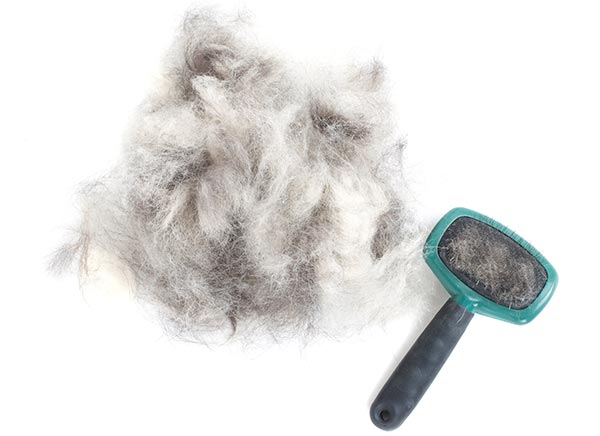Normal Dog Shedding

When you chose to bring your dog into your family, you were attracted to his great personality and appearance. His fur color and glossy coat appealed to you. While beautiful, a dog’s coat also serves an important purpose. It provides a barrier against extreme heat or cold, and protection from cuts, scrapes, and sunburn. A dog’s coat has another important characteristic: it normally sheds.
Why and how Dogs Shed
Each hair follicle in a dog’s skin has a central hair that makes up the outer or guard coat. Three to fifteen smaller hairs, the undercoat, surround each guard hair. The undercoat hairs are soft and wooly and aren’t as deeply embedded in the skin. The quantity and length of both types of hair differ by breed.
Some dogs, like collies or keeshonds, have a thick coat and shed more than dogs with thinner hair coats. Other breeds, like boxers, don’t seem to have much coat at all, but they will still shed.
Hair goes go through regular cycles of growth, maturity, and shedding. While human hairs shed randomly all year round, the process has synchronized in dogs so that all the hairs go through the cycle at the same time.
As daylight hours increase, rate of shedding increases and the haircoat becomes thinner (less dense). As daylight hours decrease, rate of shedding again increases, but an increase in hair growth also occurs resulting in a thicker hair coat.
Why Shedding is a Nuisance
While some breeds’ shedding is barely noticeable, others shed enough to fill a mattress. You’ll find tufts of fur in the corners, on your clothes, and woven into your upholstery and carpets. Even a smooth-coated breed like a Dalmatian or beagle can leave hairy evidence stuck to anything and everything.
Normal Shedding
Dogs shed heavily twice a year. This shedding is triggered by light more than temperature. As the days get longer, your dog will start to shed, even though the weather may still be very cold outside. New hairs coming in push out the older ones, making way for a lighter summer coat.
How to Deal With Normal Shedding
Once you have investigated any possible health problems in your dog, minimize normal shedding by addressing three issues: nutrition, grooming, and external parasite control.
Nutrition: Poor nutrition affects hair growth. Underfeeding or poor-quality food can result in a scruffy, dry coat and shedding. Be sure your dog’s food meets AAFCO (The Association of American Feed Control Officials) standards for essential nutrients.
Food quality varies widely, even within AAFCO standards, so you may want to consider feeding your dog a supplement to support his coat. Bio Spot Active Care™ Shed Solution® Chewable Tablets for Dogs are enriched with vitamins, minerals, and omega-6 fatty acids to support skin and coat condition and normal shedding. You can also try Bio Spot Active Care™ Shed Solution® Skin and Coat Supplement liquids, which can be added to your dog’s food to also support skin and coat nutrition.
Grooming: You can’t completely put an end to normal shedding, but the best offense is a good defense. If your dog is shedding, brush him daily. Brushing removes the loose hair so that you don’t have to clean house so often. It also distributes the natural oils in the coat and removes foreign materials like grass and debris.
Continue brushing your dog on a regular basis. You’ll notice little problems like dry skin, irritation, or fleas before they become big issues.
A good bath will help loosen coat that is ready to fall out, but over-bathing removes the natural skin oils. A healthy dog is usually pretty wash-and-wear; a bath once or twice a year is enough.
External Parasite control: Fleas can cause your dog to scratch endlessly, and thus affect his coat and overall health. Prevent flea/tick infestation and control existing fleas, ticks, and mosquitoes with a product like Bio Spot Active Care™ Flea & Tick Spot On® for Dogs.
While shedding is a normal part of your dog’s life, it doesn’t have to be a burden on you, the pet parent.